#Full Backend Development Course
Explore tagged Tumblr posts
Text
youtube
#online courses#coding#graphic designing#web design#ict skills#india#hindi#gujarati#english#www.ictskills.in#online training#live training#full stack course#digital marketing#ui ux design#backend#online#live courses#courses#education#computer science#engineering#java#python#php#dot net development company#spring mvc#javascript#Youtube
2 notes
·
View notes
Text
The Roadmap to Full Stack Developer Proficiency: A Comprehensive Guide
Embarking on the journey to becoming a full stack developer is an exhilarating endeavor filled with growth and challenges. Whether you're taking your first steps or seeking to elevate your skills, understanding the path ahead is crucial. In this detailed roadmap, we'll outline the stages of mastering full stack development, exploring essential milestones, competencies, and strategies to guide you through this enriching career journey.

Beginning the Journey: Novice Phase (0-6 Months)
As a novice, you're entering the realm of programming with a fresh perspective and eagerness to learn. This initial phase sets the groundwork for your progression as a full stack developer.
Grasping Programming Fundamentals:
Your journey commences with grasping the foundational elements of programming languages like HTML, CSS, and JavaScript. These are the cornerstone of web development and are essential for crafting dynamic and interactive web applications.
Familiarizing with Basic Data Structures and Algorithms:
To develop proficiency in programming, understanding fundamental data structures such as arrays, objects, and linked lists, along with algorithms like sorting and searching, is imperative. These concepts form the backbone of problem-solving in software development.
Exploring Essential Web Development Concepts:
During this phase, you'll delve into crucial web development concepts like client-server architecture, HTTP protocol, and the Document Object Model (DOM). Acquiring insights into the underlying mechanisms of web applications lays a strong foundation for tackling more intricate projects.
Advancing Forward: Intermediate Stage (6 Months - 2 Years)
As you progress beyond the basics, you'll transition into the intermediate stage, where you'll deepen your understanding and skills across various facets of full stack development.

Venturing into Backend Development:
In the intermediate stage, you'll venture into backend development, honing your proficiency in server-side languages like Node.js, Python, or Java. Here, you'll learn to construct robust server-side applications, manage data storage and retrieval, and implement authentication and authorization mechanisms.
Mastering Database Management:
A pivotal aspect of backend development is comprehending databases. You'll delve into relational databases like MySQL and PostgreSQL, as well as NoSQL databases like MongoDB. Proficiency in database management systems and design principles enables the creation of scalable and efficient applications.
Exploring Frontend Frameworks and Libraries:
In addition to backend development, you'll deepen your expertise in frontend technologies. You'll explore prominent frameworks and libraries such as React, Angular, or Vue.js, streamlining the creation of interactive and responsive user interfaces.
Learning Version Control with Git:
Version control is indispensable for collaborative software development. During this phase, you'll familiarize yourself with Git, a distributed version control system, to manage your codebase, track changes, and collaborate effectively with fellow developers.
Achieving Mastery: Advanced Phase (2+ Years)
As you ascend in your journey, you'll enter the advanced phase of full stack development, where you'll refine your skills, tackle intricate challenges, and delve into specialized domains of interest.
Designing Scalable Systems:
In the advanced stage, focus shifts to designing scalable systems capable of managing substantial volumes of traffic and data. You'll explore design patterns, scalability methodologies, and cloud computing platforms like AWS, Azure, or Google Cloud.
Embracing DevOps Practices:
DevOps practices play a pivotal role in contemporary software development. You'll delve into continuous integration and continuous deployment (CI/CD) pipelines, infrastructure as code (IaC), and containerization technologies such as Docker and Kubernetes.
Specializing in Niche Areas:
With experience, you may opt to specialize in specific domains of full stack development, whether it's frontend or backend development, mobile app development, or DevOps. Specialization enables you to deepen your expertise and pursue career avenues aligned with your passions and strengths.
Conclusion:
Becoming a proficient full stack developer is a transformative journey that demands dedication, resilience, and perpetual learning. By following the roadmap outlined in this guide and maintaining a curious and adaptable mindset, you'll navigate the complexities and opportunities inherent in the realm of full stack development. Remember, mastery isn't merely about acquiring technical skills but also about fostering collaboration, embracing innovation, and contributing meaningfully to the ever-evolving landscape of technology.
#full stack developer#education#information#full stack web development#front end development#frameworks#web development#backend#full stack developer course#technology
9 notes
·
View notes
Text
#What is Full Stack#What is Frontend Development#Front End Development Skills#What is Backend Development#Backend Development Skills#Who is a Full-Stack Developer#Salary of Full Stack Developer#Full Stack Development Course
1 note
·
View note
Text
MERN Stack Developer Course – Live Online Training by Experts
Master full-stack development with Sunbeam’s Live Online MERN Stack Course led by Mr. Amit Kulkarni (Certified Docker & Kubernetes Expert). Learn React JS, Node.js, Express, and MySQL with hands-on coding, real-world projects, and live Q&A. 📅 Start Date: 2nd June 2025 🕘 Time: 9:00 PM – 11:00 PM (Mon–Thu) 💰 Fees: ₹9100 (Inclusive of GST) 🎓 Includes Certification + Project + Group Discount 🔗 Register now: www.sunbeaminfo.in 📞 Call: 82 82 82 9806
✅ Group Discount Offer:
👨👩👧👦 Team of Five – Time to Thrive! 🎉 Enroll with a group of 5 and get 20% OFF on your learning journey!
✅ Course Highlights:
Frontend: ReactJS, Hooks, Axios, Routing
Backend: Node.js, Express.js, APIs
Database: MySQL CRUD operations
JWT Authentication, CORS, Middleware
RESTful Integration & Full-Stack Deployment
✅ Ideal for:
IT Students & Graduates
Working Developers
Anyone with knowledge of OOP, HTML, CSS, JS & SQL
✅ What You’ll Gain:
Full-stack development confidence
Real-world project exposure
Live instructor-led classes & doubt-clearing
Course material & Sunbeam certification
#MERN stack course#online MERN training#React JS classes#Node JS course#Express JS training#MySQL backend#Full Stack Developer course#Live coding classes#Sunbeam MERN#web development course
0 notes
Text
4 Time-Saving Tips for Getting the Most Out of an Online AI Program
The rise of artificial intelligence (AI) has created unprecedented opportunities in various industries—from finance to healthcare and beyond. Enrolling in an Artificial Intelligence and Machine Learning course is a smart investment in your future, but managing your time effectively is crucial for success, especially with self-paced online programs.
Whether you're a working professional or a student, these four time-saving tips will help you maximize your learning experience in any online AI program. Along the way, we’ll explore essential terms and tools that can enhance your understanding of artificial intelligence systems.

Related Keywords Used Naturally Throughout:
Deep learning
Neural networks
Natural language processing (NLP)
Data science
Predictive analytics
Online learning platforms
Supervised learning
AI certifications
Tip 1: Set Clear Learning Objectives and Milestones
Define What You Want to Achieve
Before diving into an AI program, take the time to outline specific goals. Are you aiming for a career in data science? Do you want to understand how neural networks work? Or perhaps you're interested in applying predictive analytics in your industry?
Setting goals will help you:
Focus on the modules that are most relevant to your interests
Allocate time according to topic complexity
Track progress with measurable milestones
Tip 2: Leverage the Right Tools and Platforms
Optimize Learning with AI-Specific Resources
Modern online learning platforms often come equipped with tools that support different learning styles. These platforms may include:
Interactive coding environments
Real-time quizzes and feedback
Peer discussion forums
Make the most of these by:
Bookmarking video lectures for quick revisits
Joining active forums to resolve doubts on complex topics like *natural language processing
Helpful Tools:
Google Collab for running Python code
GitHub for accessing and sharing AI projects
Jupiter Notebooks for visualizing data in data science tasks
Tip 3: Practice with Real-World Projects
Apply Concepts to Strengthen Understanding
Theory without practice won’t take you far in a field as hands-on as AI. Completing mini-projects or capstone assignments helps you solidify concepts and prepares you for job roles involving *machine learning algorithms* or deep learning frameworks.
Ideas for Mini Projects:
1. Sentiment analysis using NLP on Twitter data
2. Image recognition using convolutional neural networks
3. Fraud detection using supervised learning models
4. Sales forecasting with time-series predictive analytics
Spending time on these practical applications can also enhance your portfolio, which is essential if you’re seeking AI certifications or job placements.

Tip 4: Automate and Batch Your Study Sessions
Reduce Cognitive Load with Smart Scheduling
To make learning more efficient:
Batch similar tasks: Watch multiple videos in one sitting, then set aside another session for quizzes or coding exercises
Automate reminders: Use calendar apps to get notified of assignments or discussion deadlines
Utilize spaced repetition: Revisit complex topics like *neural networks* using flashcards and spaced repetition apps
By automating your study plan and reducing decision fatigue, you free up mental energy for more demanding tasks.
Conclusion
Succeeding in an Artificial Intelligence and Machine Learning course requires more than just logging in and watching videos. With clear objectives, the right tools, hands-on projects, and smart scheduling, you can not only save time but also deeply understand core concepts like natural language processing, data science, and deep learning. These time-saving strategies are essential for anyone looking to thrive in online AI programs and ultimately, the AI-driven workforce.
Frequently Asked Questions (FAQ)
1. What is the best way to start learning artificial intelligence and machine learning online?
The best way to start is by choosing a structured online AI program that offers foundational content on machine learning, neural networks, and data science. Set clear goals and follow a time-managed schedule.
Learn more about Artificial Intelligence and Machine Learning course here.
2. How long does it take to complete an online AI program?
Most self-paced courses take between 3 to 6 months, while intensive boo camps may last 8 to 12 weeks. Your prior experience with programming or predictive analytics can also affect completion time.
3. What are some useful projects to include in an AI portfolio?
Strong portfolios include real-world applications such as image classification, chatbot development using NLP , fraud detection systems, or data visualization dashboards using data science* tools. Projects that showcase the implementation of neural networks or deep learning models are particularly valuable.
4. Are AI certifications from online courses worth it?
Yes, certifications from reputable platforms can enhance your resume and demonstrate proficiency in tools and concepts like natural language processing, data science, and machine learning algorithms. They are especially useful for career changers or professionals seeking roles in tech and analytics.
5. How do I stay consistent while learning AI online?
Maintaining consistency involves setting a fixed schedule, minimizing distractions, and using reminders to stay on track. Batching tasks, leveraging active recall, and regularly reviewing learned material also contribute to long-term retention.
#Advanced Full Stack Developer Program Jaipur#Best Software Development Training Institute in Jaipur#Industry-Oriented Software Internship Course#Best Full Stack Coaching with Live Projects Jaipur#Frontend and Backend Development Courses Jaipur
0 notes
Text
Does learning Java increase my salary?
1. Introduction to the Java Job Market
Java is still one of the hottest programming languages out there. Whether you're just starting or have been coding for a while, knowing Java can really help your career. A common question is: Does learning Java boost my paycheck? The answer is yes—companies really want people who know Java because it's so flexible for web, mobile, and big business apps. Key topics include Java programming, Java developers, and job roles related to it.
Key Point: Java skills are in demand across different industries and can help increase your salary.
2. Java's Popularity and Market Demand
Big names like Amazon, Netflix, and Google use Java because it handles large-scale apps well. So, does learning Java increase my salary? Definitely. Employers will pay a premium for those who are good at Java. Key terms include Java software development, full stack, and backend developer.
Key Point: There’s a strong demand for Java devs, which leads to better pay and job security.
3. Java Skills and Salary Growth
Having Java skills gives you an edge. Companies are looking for people who know frameworks like Spring Boot and tools like Maven. Will learning Java increase my salary? For sure. With the right certifications and experience, you can earn more. And signing up for a Java course in Coimbatore can really help solidify your skills.
Key Point: Specialized Java knowledge can lead to promotions and salary increases.
4. Role of Certifications in Salary Hike
Getting a Java certification is a smart way to stand out. A lot of people choose the Java Full Stack Developer Course in Coimbatore for hands-on practice. Certifications prove your skills, and the answer to the question: Does learning Java bump up my salary? Yes.
Key Point: Java certifications help validate your skills and can lead to better pay.
5. Java Job Roles and Their Pay Scales
Java jobs range from junior developers to senior architects, and each level comes with higher pay. A Java training in Coimbatore can get you ready for roles like Full Stack Developer or Software Engineer. Is there a salary increase if you learn Java? Absolutely, especially for specialized roles.
Key Point: There are many roles in Java, and each offers attractive salary packages.
6. Java vs. Other Programming Languages in Salary
Java developers often earn more than those working with less popular languages. Unlike some newer languages, Java jobs tend to be more stable. Does learning Java mean better pay? Yes, compared to other languages, Java usually offers more consistent salaries.
Key Point: Java's long-standing presence in the industry generally means better pay than many newer languages.
7. Full Stack Java Developer Salary Benefits
Full Stack Java Developers are among the best paid in tech. Taking a Java Full Stack Developer Course in Coimbatore can prepare you for the job market. Will learning Java increase my salary? For sure—especially in full stack roles where you need to be skilled in both backend and frontend.
Key Point: Full Stack Java positions offer top salaries and are in high demand.
8. Java's Role in Enterprise Applications
Java is key for many enterprise systems. Learning enterprise-level Java can really answer the question: Does it help me earn more? Yes. A training program in Coimbatore that teaches things like Hibernate and JSP is worth considering.
Key Point: Skills in enterprise Java can set you up for well-paying jobs.
9. Local Training Institutes and Career Impact
Joining a local Java course in Coimbatore can boost your earnings. These programs offer hands-on projects and guidance from experts. So, does learning Java help with salary? Yes—local training can lead to quicker job growth.
Key Point: Local Java training can speed up your skills and help with job placements.
10. Final Thoughts and Brand Mention
In summary, does learning Java increase my salary? Yes, through certifications, full stack skills, and local training. Consider a reputable place like Xplore It Corp for training in Coimbatore, offering courses designed to meet job market needs.
Key Point: Xplore It Corp provides practical Java courses that can help you earn more.
FAQs:
1. Does learning Java help me earn more with no experience?
Yes. Even beginners can get better job offers after certified Java training.
2. What’s the average salary after a Java course in Coimbatore?
Freshers typically earn around ₹3-5 LPA, and pay can increase significantly after 1-2 years.
3. Is a Java Full Stack Developer Course in Coimbatore worth it?
Definitely. Full stack developers are in demand and usually earn 20-30% more.
4. How long before I see salary benefits after Java training?
Usually, you can expect to see salary increases within 6-12 months after completing the course.
5. Can I switch to Java and expect a pay increase?
Yes. Many people move from non-tech jobs to Java and see a boost in their salary.
#Java programming#Java developer#Java applications#Core Java#Java certification#Java frameworks#Spring Framework#Java full stack#Java backend developer#Java software development#Java training course#Java job roles#Object-oriented programming#Java IDE#Java runtime environment#Java REST API#J2EE#Java vs Python#Java vs JavaScript#Secure Java coding#Java deployment#Java enterprise solutions#Java bootcamp#Java multithreading#Java performance optimization
0 notes
Text
#digital marketing course in lucknow#best programming language for hacking#website designing course in lucknow#full stack framework#hotel digital marketing#best programing language for hacking#digital marketing training in lucknow#social media marketing in lucknow#best language for hacking#social media marketing projects for students#digital marketing course lucknow#summer training in lucknow#why we need data structure#django is frontend or backend#best digital marketing course in lucknow#social media marketing lucknow#online pr in digital marketing#digital marketing projects for students#best coding language for hacking#web development lucknow
0 notes
Text
Java Full Stack Developer Course | Land Your Dream Job
Are you looking to build a career as a Java Full Stack Developer? Our comprehensive Java Full Stack Developer Course is designed to help you master both frontend and backend technologies, making you industry-ready.
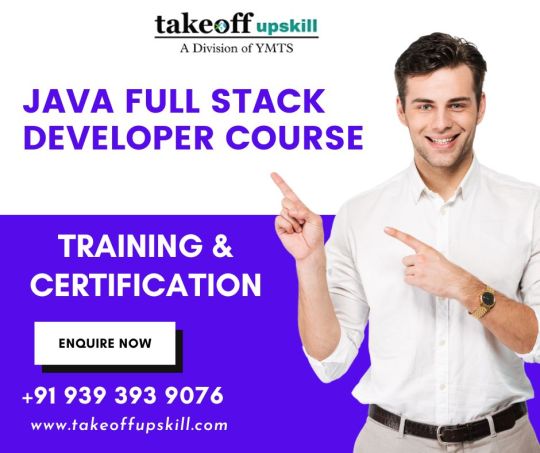
Why Choose a Java Full Stack Developer Course?
A full stack developer is skilled in handling both client-side and server-side development. With expertise in Java, databases, frameworks, and cloud technologies, you become a versatile IT professional.
What You Will Learn:
✅ Frontend Development – HTML, CSS, JavaScript, React.js/Angular ✅ Backend Development – Core Java, Spring Boot, REST APIs ✅ Database Management – MySQL, MongoDB ✅ DevOps & Deployment – Docker, Kubernetes, AWS ✅ Project-Based Learning – Real-world applications and hands-on experience
Benefits of Learning Java Full Stack Development:
High demand for full stack developers in the job market
Competitive salary and career growth opportunities
Versatility to work on different projects and technologies
Mastery of Java frameworks, APIs, and databases
Who Should Enroll?
This course is ideal for: ✔ Beginners aiming for a career in full-stack development ✔ Software professionals looking to upskill ✔ Students and freshers interested in web development
Enroll Now & Kick-start Your Java Full Stack Development Journey!
Gain hands-on experience, work on live projects, and get job-ready with our expert-led training.
#Java Full Stack Developer Course#Java Full Stack Training#Full Stack Development with Java#Java Full Stack Online Course#Learn Java Full Stack#Java Web Development Course#Best Java Full Stack Course#Java Backend and Frontend Training#Full Stack Java Developer Certification#Java Full Stack Developer Skills.
0 notes
Text
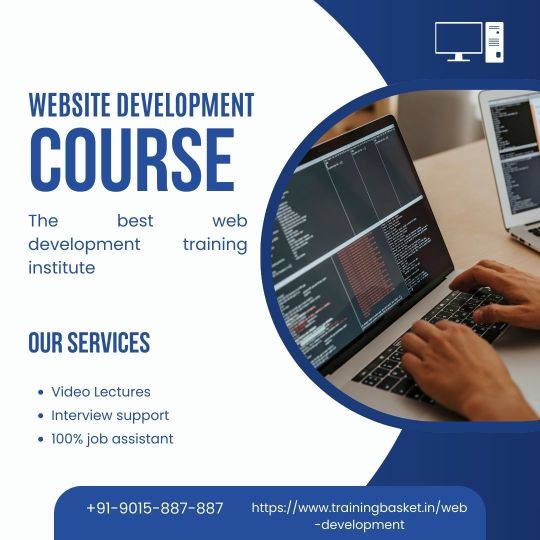
Web Development Training Program is an excellent opportunity for students to gain practical experience designing and developing websites. In this program, participants will get hands-on experience in the latest tools and techniques used in web development, including HTML, CSS, JavaScript, frameworks like React and Angular, and many more.
Source : https://www.trainingbasket.in/web-development
#web development course#web development training#backend development#frontend development#full stack development
1 note
·
View note
Text

#corporatetraining#ittraining#full stack training#full stack course#blockchain#blockchain development#phpdevelopment#pythondevelopment#javascriptdevelopment#ui ux development services#digital marketing#html css#html5#frontend#learn to code#backend#software#information technology
0 notes
Text
Unveiling the Essential Role of Full Stack Developers in Modern Web Development
Introduction:
Within the dynamic realm of web development, full stack developers stand out as indispensable assets, offering a unique blend of expertise in both frontend and backend technologies. Their versatility enables them to navigate through various aspects of web application development, from crafting user interfaces to managing databases and server-side logic.
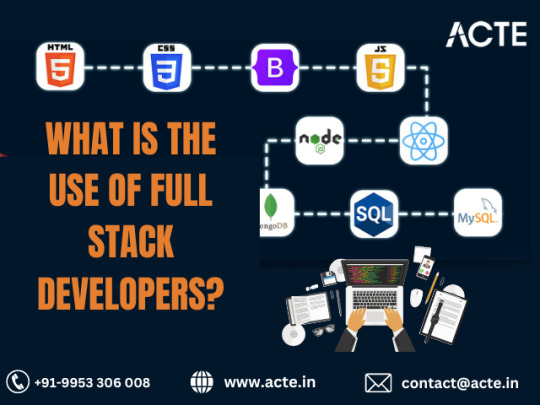
In this article, we'll delve into the essential role of full stack developers, shedding light on their pivotal contributions to streamlining development processes and fostering innovation within the industry.
1. Comprehensive Development Capabilities:
An integral aspect of full stack developers lies in their adeptness at overseeing end-to-end development projects. From initial concept to deployment, these professionals are proficient in every stage of the development lifecycle. They excel at designing intuitive user interfaces, implementing intricate frontend functionality, crafting robust backend logic, seamlessly integrating databases, and orchestrating smooth deployment of applications. This holistic approach ensures coherence and uniformity across the entirety of the project.
2. Proficient Problem Solvers:
Full stack developers possess a profound understanding of both frontend and backend technologies, equipping them with the skills to address issues at varying levels of the application stack. Their extensive skill set enables them to identify and resolve challenges efficiently, thereby minimizing downtime and ensuring the seamless operation of web applications. Whether it entails debugging frontend UI glitches or optimizing backend performance, full stack developers excel in devising effective solutions to intricate technical hurdles.
3. Collaborative Cross-Functional Engagement:
Effective collaboration is paramount in any development endeavor, and full stack developers are adept at fostering cross-functional teamwork. With their comprehensive grasp of frontend and backend technologies, they facilitate seamless communication and collaboration among designers, frontend developers, backend developers, and project managers. This cohesive teamwork ensures alignment on project objectives and facilitates smooth execution of tasks throughout the development journey.
4. Streamlined Development Processes:
The presence of a single developer proficient in both frontend and backend tasks results in a more streamlined and efficient development process. Full stack developers seamlessly transition between frontend and backend development, thereby mitigating communication gaps and reducing the need for handoffs between different team members. This streamlined approach translates into faster development cycles, rapid iterations, and ultimately, shortened time-to-market for web applications.
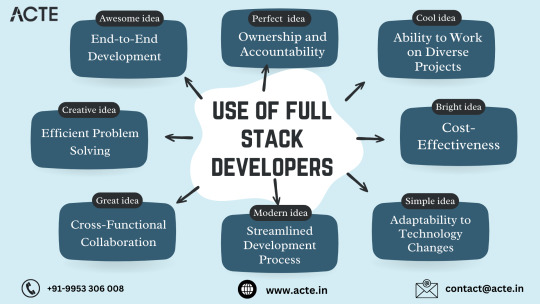
5. Adaptability to Technological Advancements:
In a landscape characterized by constant evolution, full stack developers are well-equipped to adapt to emerging trends and integrate new technologies into their projects. Their ability to stay abreast of the latest developments ensures they remain at the forefront of innovation in web development, thereby enabling them to deliver cutting-edge solutions tailored to meet the evolving needs of clients and users alike.
6. Cost-Efficiency:
Employing separate specialists for frontend and backend development can incur substantial costs for businesses. Conversely, engaging a full stack developer who can adeptly handle both roles offers a more cost-effective alternative. This approach not only reduces development expenditures but also minimizes overhead and administrative burdens associated with project management. Furthermore, having a singular point of contact for development tasks enhances communication and expedites decision-making processes.
7. Versatility in Project Execution:
Full stack developers possess the versatility to tackle a diverse array of projects, ranging from simple websites to complex web applications. This flexibility enables them to address varied challenges and contribute effectively to a wide spectrum of projects. Whether it involves crafting e-commerce platforms, content management systems, or social networking sites, full stack developers boast the expertise and adaptability to deliver bespoke solutions tailored to the unique requirements of each project.
8. Ownership and Commitment:
Often assuming ownership of the projects they undertake, full stack developers exhibit a heightened sense of accountability and dedication. This intrinsic ownership fosters a greater commitment to project success, as developers become personally invested in achieving favorable outcomes. By assuming responsibility for the entire development process, full stack developers ensure projects are delivered punctually, within budget constraints, and in adherence to the highest quality standards.
Conclusion:
In summary, full stack developers occupy a pivotal position in the realm of web development, leveraging their versatile skill sets and comprehensive understanding of frontend and backend technologies to drive innovation and excellence. By harnessing the unique capabilities of full stack developers, businesses can streamline development processes, stimulate innovation, and deliver unparalleled web experiences to their audience.
#full stack developer#education#information#full stack web development#front end development#frameworks#web development#backend#full stack developer course#technology
4 notes
·
View notes
Text
What is coding for kids
#web development#front end web development#web development roadmap#web development guide#learn web development#app development#backend web development#full stack web development#software development#development#web development tutorial#web development projects#web development tutorial for beginners#what is web development#web development course#web development skills
1 note
·
View note
Text

Master full-stack development with Sunbeam’s Live Online MERN Stack Course led by Mr. Amit Kulkarni (Certified Docker & Kubernetes Expert). Learn React JS, Node.js, Express, and MySQL with hands-on coding, real-world projects, and live Q&A. 📅 Start Date: 2nd June 2025 🕘 Time: 9:00 PM – 11:00 PM (Mon–Thu) 💰 Fees: ₹9100 (Inclusive of GST) 🎓 Includes Certification + Project + Group Discount 🔗 Register now: www.sunbeaminfo.in 📞 Call: 82 82 82 9806
✅ Group Discount Offer:
👨👩👧👦 Team of Five – Time to Thrive! 🎉 Enroll with a group of 5 and get 20% OFF on your learning journey!
✅ Course Highlights:
Frontend: ReactJS, Hooks, Axios, Routing
Backend: Node.js, Express.js, APIs
Database: MySQL CRUD operations
JWT Authentication, CORS, Middleware
RESTful Integration & Full-Stack Deployment
✅ Ideal for:
IT Students & Graduates
Working Developers
Anyone with knowledge of OOP, HTML, CSS, JS & SQL
✅ What You’ll Gain:
Full-stack development confidence
Real-world project exposure
Live instructor-led classes & doubt-clearing
Course material & Sunbeam certification
#MERN stack course#online MERN training#React JS classes#Node JS course#Express JS training#MySQL backend#Full Stack Developer course#Live coding classes#Sunbeam MERN#web development course
0 notes
Text
From Frontend to Backend: The Art and Science of Full Stack Web Development

Introduction
In the dynamic realm of web development, the term "Full Stack" has become synonymous with versatility and expertise. A Full Stack Web Developer is a master of both frontend and backend development, seamlessly navigating the intricate dance between user interfaces and server-side operations. This blog explores the art and science behind full stack web development, delving into the essential components of frontend and backend development.
Frontend Development: Crafting User Experiences
Frontend development is the creative and user-centric facet of web development. It involves designing and implementing the visual elements that users interact with. From the layout and aesthetics to the responsiveness and overall user experience, frontend development plays a crucial role in capturing and retaining a user's attention.
1. User Interface (UI) Design:
Frontend developers focus on creating visually appealing and intuitive user interfaces. This involves using HTML, CSS, and JavaScript to structure content, style elements, and add interactivity.
2. Responsive Design:
With the proliferation of various devices, ensuring a seamless user experience across different screen sizes is paramount. Frontend developers utilize responsive design techniques to adapt websites to various devices, promoting accessibility and usability.
3. Client-Side Scripting:
JavaScript, the powerhouse of client-side scripting, enables developers to add dynamic elements to websites. From interactive forms to real-time updates, JavaScript enhances user engagement on the frontend.
Backend Development: The Engine Behind the Curtain
While frontend development focuses on what users see and interact with, backend development is the behind-the-scenes work that powers the entire system. It involves server-side scripting, databases, and server management to ensure data is processed, stored, and delivered efficiently.
1. Server-Side Programming Languages:
Backend developers work with languages like Python, Ruby, PHP, and Node.js to build the logic that runs on the server. This logic manages data, processes requests, and communicates with databases.
2. Database Management:
Storing and retrieving data is a critical aspect of web development. Backend developers use databases like MySQL, PostgreSQL, or MongoDB to manage and organize data efficiently, ensuring seamless interactions between the frontend and backend.
3. APIs (Application Programming Interfaces):
APIs serve as bridges between the frontend and backend, allowing them to communicate and share data. Backend developers design and implement APIs that enable different components of a web application to work together cohesively.
The Full Stack Experience: Bridging Frontend and Backend
Full Stack Web Developers possess the expertise to seamlessly transition between frontend and backend tasks, creating cohesive and fully functional web applications. Their ability to understand the entire development process allows them to optimize performance, enhance user experiences, and troubleshoot issues effectively.
Conclusion
In the evolving landscape of web development, the role of Full Stack Web Developers stands out as both an art and a science. Mastering both frontend and backend development empowers developers to create holistic and efficient web solutions. As technology continues to advance, the demand for Full Stack Developers will persist, making their skills an invaluable asset in the ever-expanding digital frontier. Whether you're passionate about crafting user interfaces or optimizing server-side operations, embracing the full stack approach opens doors to endless possibilities in the dynamic world of web development.
#backend development#full stack course#attitude academy#enrollnow#learnwithattitudeacademy#attitude tally academy#bestcourse
0 notes
Text
Java Full-Stack Devs: The Skills You Need to Slay the Stack
Are you interested in pursuing a career as a Java Full-Stack Developer? In today's technology-driven world, this role is in high demand and offers promising career prospects. But what exactly does it mean to be a Java Full-Stack Developer, and what skills do you need to excel in this field? In this article, we will explore the ins and outs of becoming a Java Full-Stack Developer and provide you with valuable insights and resources to get started on your journey.
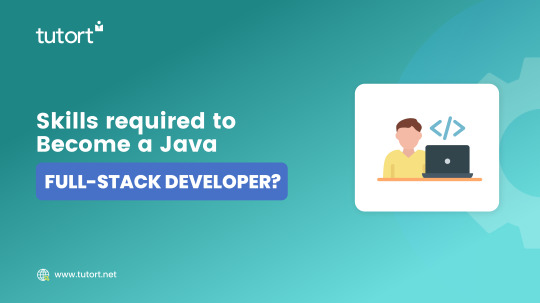
What is a Java Full-Stack Developer?
A Java Full-Stack Developer is an engineer who possesses the skills and expertise to work on both the frontend (client-side) and backend (server-side) of software applications. They have a deep understanding of Java, an object-oriented programming language that is widely used for web development, as well as proficiency in other essential technologies and frameworks.
In simple terms, a Java Full-Stack Developer is a versatile professional who can handle various aspects of software development, from designing user interfaces to managing databases and building robust backend systems. They bridge the gap between the frontend and backend, ensuring seamless communication and functionality between the two.
Essential Skills for Java Full-Stack Developers
To become a successful Java Full-Stack Developer, you need to acquire a specific set of skills that are in high demand in the industry. Let's dive into the top skills you need to focus on:
1. Proficiency in Java
As the name suggests, being a Java Full-Stack Developer requires a strong command of the Java programming language. You should be comfortable writing clean, efficient, and maintainable code using Java. This includes understanding object-oriented programming concepts, data structures, algorithms, and design patterns.
2. Front End Development Skills
A Java Full-Stack Developer should be well-versed in frontend technologies such as HTML, CSS, and JavaScript. These skills are essential for creating visually appealing and interactive user interfaces. Familiarity with frontend frameworks like React and Angular can also give you an edge in the job market.
3. Backend Development Skills
In addition to frontend development, you need to have a solid foundation in backend technologies. This includes knowledge of server-side programming languages like Java, as well as frameworks such as Spring and Hibernate. Understanding databases, data modeling, and SQL is crucial for building robust backend systems.
4. Version Control Systems (VCS)
Version Control Systems like Git and GitHub are essential tools for developers. They allow you to track changes, collaborate with team members, and manage code repositories effectively. Familiarize yourself with basic Git commands and practices to streamline your development workflow.
5. Web Architecture
Full-Stack Developers should have a good understanding of web architecture and how different components interact with each other. This includes knowledge of DNS (Domain Name System), database servers, cloud storage, and other structural and user interface elements of web applications.
6. HTTP and REST
HTTP (Hypertext Transfer Protocol) and REST (Representational State Transfer) are fundamental technologies used in web development. Understanding how these protocols work and how to utilize them to communicate between the frontend and backend is crucial for a Java Full-Stack Developer.
7. Database Management
Full-Stack Developers need to be proficient in working with databases. This includes knowledge of both relational and non-relational databases, as well as query languages like SQL. Understanding database design, normalization, and data manipulation is essential for creating efficient and scalable applications.
8. DevOps Tools
DevOps practices are becoming increasingly important in software development. Familiarize yourself with tools like Jenkins, Docker, and Kubernetes, which help automate the development, testing, and deployment processes. These skills will make you more efficient and enable you to work seamlessly in a collaborative environment.
9. Soft Skills
In addition to technical skills, soft skills are crucial for a Java Full-Stack Developer. These include effective communication, problem-solving abilities, time management, and the ability to work in a team. Developing your soft skills will not only enhance your productivity but also make you a valuable asset in any development team.
To get started with becoming a successful Java Full-Stack Developer, explore the different course options available online and choose the one that aligns with your career goals. Check out Tutort Academy Full-Stack Developer Courses!
Once you have chosen a course, start learning! Be sure to practice what you learn by building your own projects. This is the best way to solidify your skills and knowledge.
#fullstackdevelopment#fullstackdeveloper#javafullstackdeveloper#java full stack course#software development#software development courses#tutortacdemy#tutort#frontend#backend
0 notes
Text
#digital marketing course in lucknow#best programming language for hacking#website designing course in lucknow#full stack framework#hotel digital marketing#best programing language for hacking#digital marketing training in lucknow#social media marketing in lucknow#best language for hacking#social media marketing projects for students#digital marketing course lucknow#summer training in lucknow#why we need data structure#django is frontend or backend#best digital marketing course in lucknow#social media marketing lucknow#online pr in digital marketing#digital marketing projects for students#best coding language for hacking#web development lucknow
0 notes